International Trade, Finance, and Investment: A Comprehensive Report
VerifiedAdded on 2023/01/18
|13
|3925
|1
Report
AI Summary
This report provides an in-depth analysis of international trade, finance, and investment. It begins with an executive summary, followed by an overview of financial markets, capital allocation in both domestic (UK) and international economies, and a discussion of relevant trade, financial, and investment theories, including the Ricardian trade theory and its concepts of opportunity cost and comparative advantage. The report then explores the role of the World Trade Organization (WTO), regional trade agreements (EFTA), and investment treaties (FDI) in international trade. The second part of the report focuses on China as a representative of the BRICS nations, evaluating its economic growth, the challenges it faces due to industrialization, and issues arising from its relationship with the WTO. The report concludes with a comprehensive overview of the complexities and opportunities within the global trade landscape.
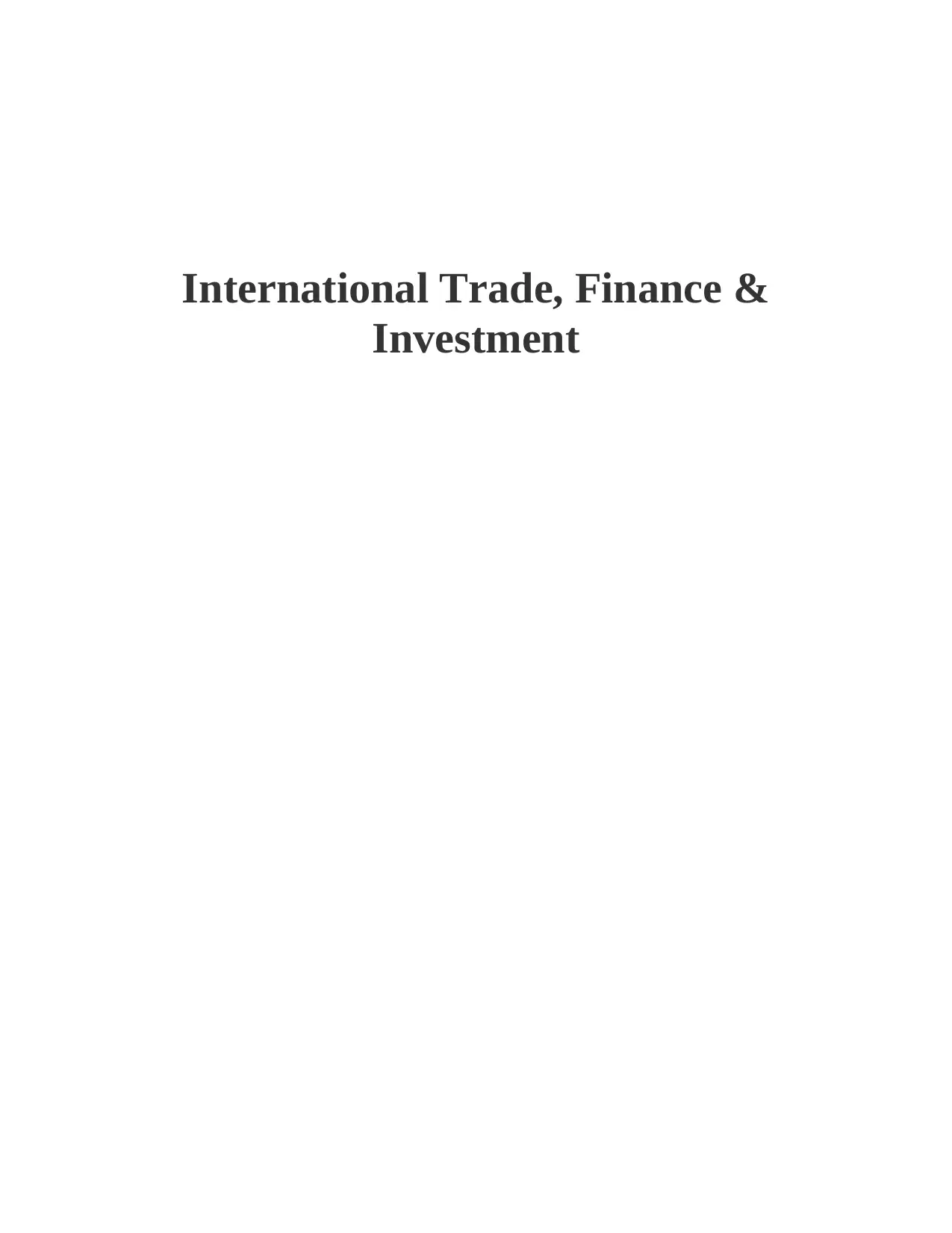
International Trade, Finance &
Investment
Investment
Paraphrase This Document
Need a fresh take? Get an instant paraphrase of this document with our AI Paraphraser
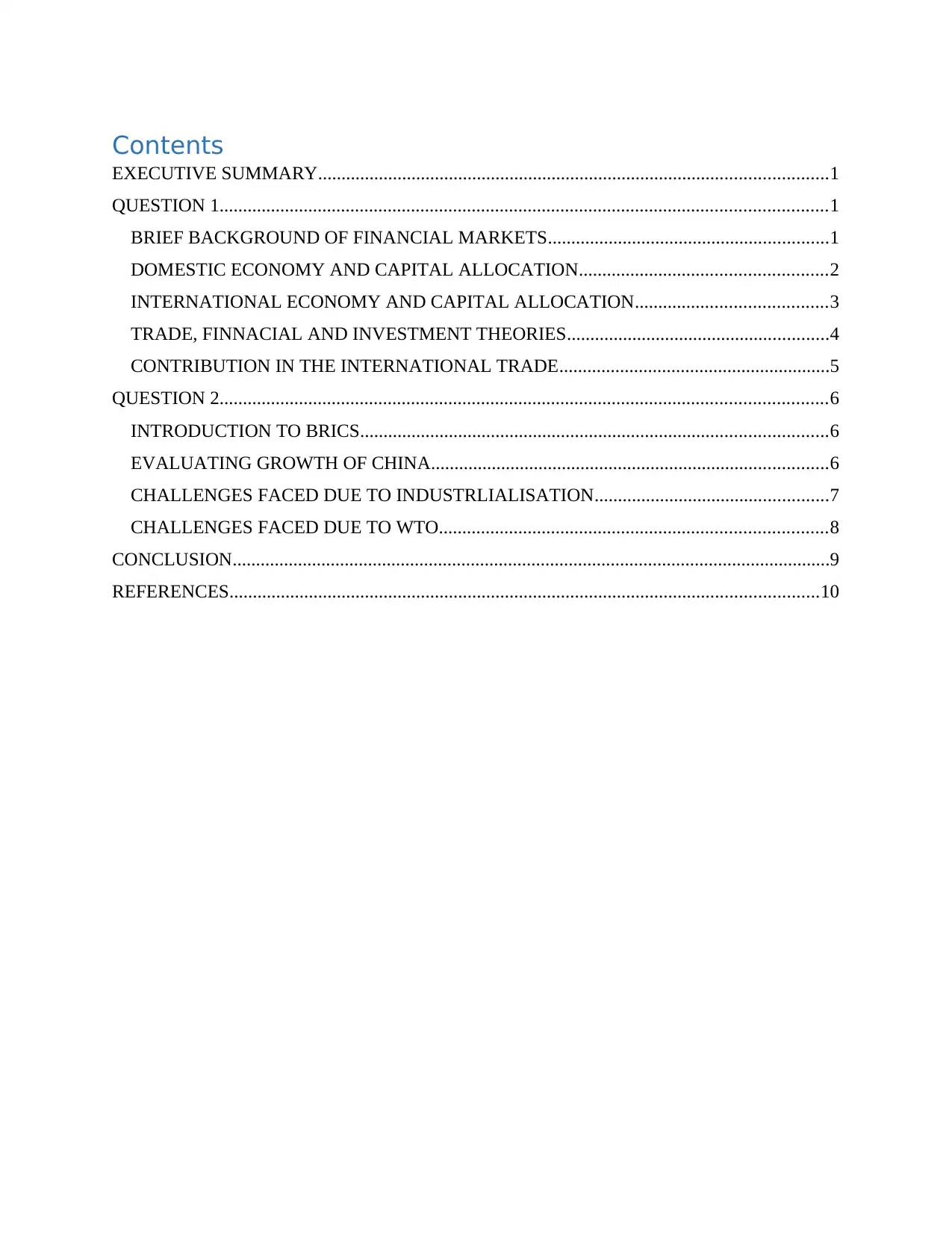
Contents
EXECUTIVE SUMMARY.............................................................................................................1
QUESTION 1..................................................................................................................................1
BRIEF BACKGROUND OF FINANCIAL MARKETS............................................................1
DOMESTIC ECONOMY AND CAPITAL ALLOCATION.....................................................2
INTERNATIONAL ECONOMY AND CAPITAL ALLOCATION.........................................3
TRADE, FINNACIAL AND INVESTMENT THEORIES........................................................4
CONTRIBUTION IN THE INTERNATIONAL TRADE..........................................................5
QUESTION 2..................................................................................................................................6
INTRODUCTION TO BRICS....................................................................................................6
EVALUATING GROWTH OF CHINA.....................................................................................6
CHALLENGES FACED DUE TO INDUSTRLIALISATION..................................................7
CHALLENGES FACED DUE TO WTO...................................................................................8
CONCLUSION................................................................................................................................9
REFERENCES..............................................................................................................................10
EXECUTIVE SUMMARY.............................................................................................................1
QUESTION 1..................................................................................................................................1
BRIEF BACKGROUND OF FINANCIAL MARKETS............................................................1
DOMESTIC ECONOMY AND CAPITAL ALLOCATION.....................................................2
INTERNATIONAL ECONOMY AND CAPITAL ALLOCATION.........................................3
TRADE, FINNACIAL AND INVESTMENT THEORIES........................................................4
CONTRIBUTION IN THE INTERNATIONAL TRADE..........................................................5
QUESTION 2..................................................................................................................................6
INTRODUCTION TO BRICS....................................................................................................6
EVALUATING GROWTH OF CHINA.....................................................................................6
CHALLENGES FACED DUE TO INDUSTRLIALISATION..................................................7
CHALLENGES FACED DUE TO WTO...................................................................................8
CONCLUSION................................................................................................................................9
REFERENCES..............................................................................................................................10

⊘ This is a preview!⊘
Do you want full access?
Subscribe today to unlock all pages.

Trusted by 1+ million students worldwide

EXECUTIVE SUMMARY
International trade, finance and investment is a field of study in which concepts related to
financial markets are reviewed in order to make an informed decision so that relevant profits can
be gained by investing in international trade (Bhandari and Javakhadze, 2017). The main aim of
this report is to develop an understanding about capital allocation in domestic and international
economy. The below report has covered background information about financial markets along
with ways by which finance can be allocated in these markets. In the second part of this report, a
BRICS organisation is selected which is China. The reason behind selecting this organisation
was the developing finance industry of this region. Various challenges and problems are
identified which this nation is facing due to industrialisation development. Issues arising from
organisations such as WTO against China are also evaluated in this report so that potentiality of
this nation can be ascertained.
QUESTION 1
BRIEF BACKGROUND OF FINANCIAL MARKETS
Financial market is a market place where financial instruments are traded between parties.
This market involves trading of various securities such as stocks, bonds, commodities etc. All
these instruments are traded and managed by parties which includes key players of market which
are intermediaries (brokers), individual investors and regulators. Financial markets are broadly
classified into two classes which are debt and equity.
Equity financial market – It is a stock market in which securities such as shares are
bought and sold. Examples of these markets are London Stock Exchange (LSE), New York
Stock Exchange (NYSE) etc. Equity shares are traded between the parties in this market in which
companies holding the securities does not intervene. Equity market involves high risk as the
price value of the securities can be changed due to various reasons (Bolton, Santos and
Scheinkman, 2016).
Debt financial market – This is a bond market in which parties make investments by
providing loans at which they earn interest. This market is considered as less risky interface as
price of their investments does not change, bondholders are the first ones to be paid if the
company is liquidated and even fixed interest is also gained against the loan given. Along with
the risk, return on investment in this market is also low.
1
International trade, finance and investment is a field of study in which concepts related to
financial markets are reviewed in order to make an informed decision so that relevant profits can
be gained by investing in international trade (Bhandari and Javakhadze, 2017). The main aim of
this report is to develop an understanding about capital allocation in domestic and international
economy. The below report has covered background information about financial markets along
with ways by which finance can be allocated in these markets. In the second part of this report, a
BRICS organisation is selected which is China. The reason behind selecting this organisation
was the developing finance industry of this region. Various challenges and problems are
identified which this nation is facing due to industrialisation development. Issues arising from
organisations such as WTO against China are also evaluated in this report so that potentiality of
this nation can be ascertained.
QUESTION 1
BRIEF BACKGROUND OF FINANCIAL MARKETS
Financial market is a market place where financial instruments are traded between parties.
This market involves trading of various securities such as stocks, bonds, commodities etc. All
these instruments are traded and managed by parties which includes key players of market which
are intermediaries (brokers), individual investors and regulators. Financial markets are broadly
classified into two classes which are debt and equity.
Equity financial market – It is a stock market in which securities such as shares are
bought and sold. Examples of these markets are London Stock Exchange (LSE), New York
Stock Exchange (NYSE) etc. Equity shares are traded between the parties in this market in which
companies holding the securities does not intervene. Equity market involves high risk as the
price value of the securities can be changed due to various reasons (Bolton, Santos and
Scheinkman, 2016).
Debt financial market – This is a bond market in which parties make investments by
providing loans at which they earn interest. This market is considered as less risky interface as
price of their investments does not change, bondholders are the first ones to be paid if the
company is liquidated and even fixed interest is also gained against the loan given. Along with
the risk, return on investment in this market is also low.
1
Paraphrase This Document
Need a fresh take? Get an instant paraphrase of this document with our AI Paraphraser
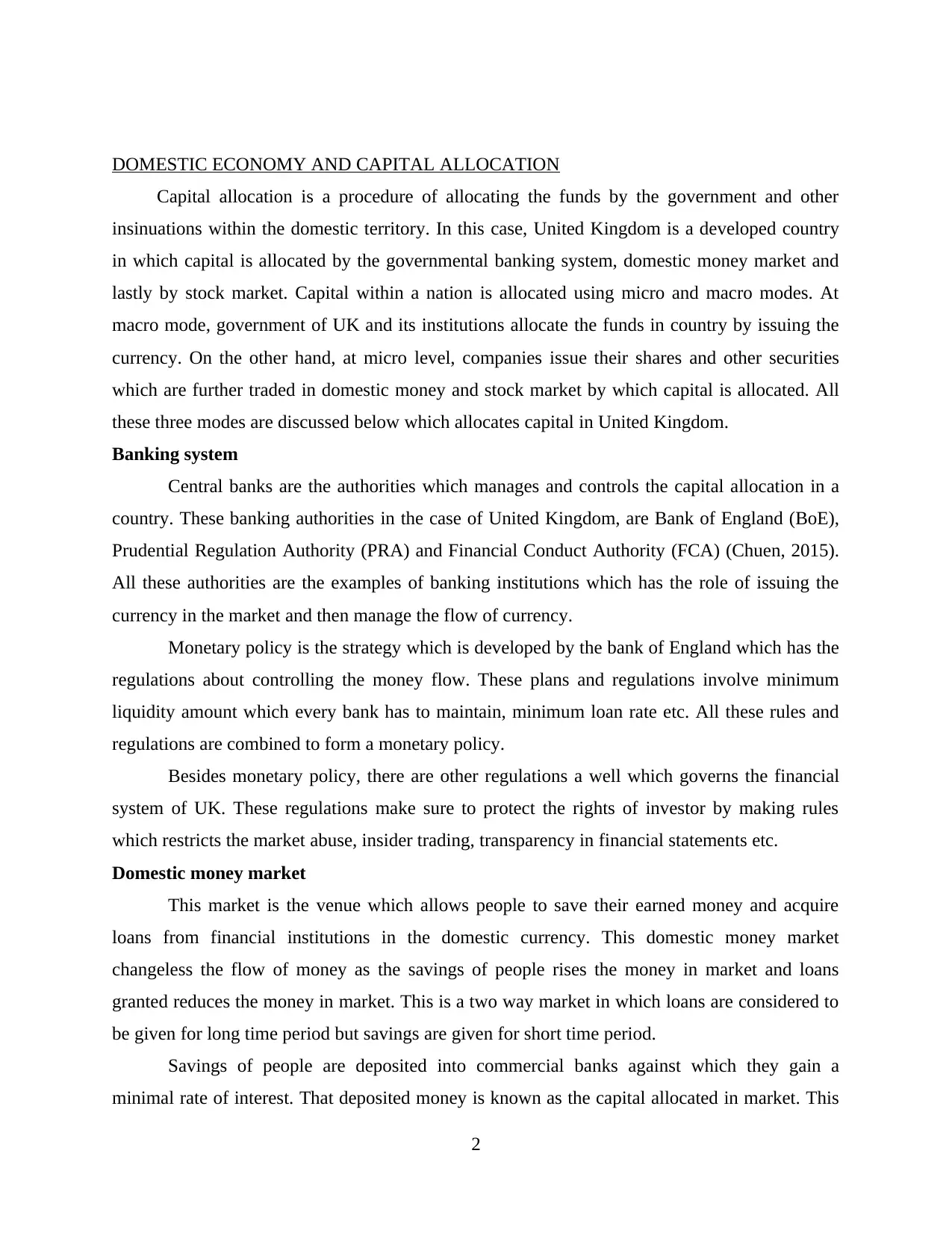
DOMESTIC ECONOMY AND CAPITAL ALLOCATION
Capital allocation is a procedure of allocating the funds by the government and other
insinuations within the domestic territory. In this case, United Kingdom is a developed country
in which capital is allocated by the governmental banking system, domestic money market and
lastly by stock market. Capital within a nation is allocated using micro and macro modes. At
macro mode, government of UK and its institutions allocate the funds in country by issuing the
currency. On the other hand, at micro level, companies issue their shares and other securities
which are further traded in domestic money and stock market by which capital is allocated. All
these three modes are discussed below which allocates capital in United Kingdom.
Banking system
Central banks are the authorities which manages and controls the capital allocation in a
country. These banking authorities in the case of United Kingdom, are Bank of England (BoE),
Prudential Regulation Authority (PRA) and Financial Conduct Authority (FCA) (Chuen, 2015).
All these authorities are the examples of banking institutions which has the role of issuing the
currency in the market and then manage the flow of currency.
Monetary policy is the strategy which is developed by the bank of England which has the
regulations about controlling the money flow. These plans and regulations involve minimum
liquidity amount which every bank has to maintain, minimum loan rate etc. All these rules and
regulations are combined to form a monetary policy.
Besides monetary policy, there are other regulations a well which governs the financial
system of UK. These regulations make sure to protect the rights of investor by making rules
which restricts the market abuse, insider trading, transparency in financial statements etc.
Domestic money market
This market is the venue which allows people to save their earned money and acquire
loans from financial institutions in the domestic currency. This domestic money market
changeless the flow of money as the savings of people rises the money in market and loans
granted reduces the money in market. This is a two way market in which loans are considered to
be given for long time period but savings are given for short time period.
Savings of people are deposited into commercial banks against which they gain a
minimal rate of interest. That deposited money is known as the capital allocated in market. This
2
Capital allocation is a procedure of allocating the funds by the government and other
insinuations within the domestic territory. In this case, United Kingdom is a developed country
in which capital is allocated by the governmental banking system, domestic money market and
lastly by stock market. Capital within a nation is allocated using micro and macro modes. At
macro mode, government of UK and its institutions allocate the funds in country by issuing the
currency. On the other hand, at micro level, companies issue their shares and other securities
which are further traded in domestic money and stock market by which capital is allocated. All
these three modes are discussed below which allocates capital in United Kingdom.
Banking system
Central banks are the authorities which manages and controls the capital allocation in a
country. These banking authorities in the case of United Kingdom, are Bank of England (BoE),
Prudential Regulation Authority (PRA) and Financial Conduct Authority (FCA) (Chuen, 2015).
All these authorities are the examples of banking institutions which has the role of issuing the
currency in the market and then manage the flow of currency.
Monetary policy is the strategy which is developed by the bank of England which has the
regulations about controlling the money flow. These plans and regulations involve minimum
liquidity amount which every bank has to maintain, minimum loan rate etc. All these rules and
regulations are combined to form a monetary policy.
Besides monetary policy, there are other regulations a well which governs the financial
system of UK. These regulations make sure to protect the rights of investor by making rules
which restricts the market abuse, insider trading, transparency in financial statements etc.
Domestic money market
This market is the venue which allows people to save their earned money and acquire
loans from financial institutions in the domestic currency. This domestic money market
changeless the flow of money as the savings of people rises the money in market and loans
granted reduces the money in market. This is a two way market in which loans are considered to
be given for long time period but savings are given for short time period.
Savings of people are deposited into commercial banks against which they gain a
minimal rate of interest. That deposited money is known as the capital allocated in market. This
2
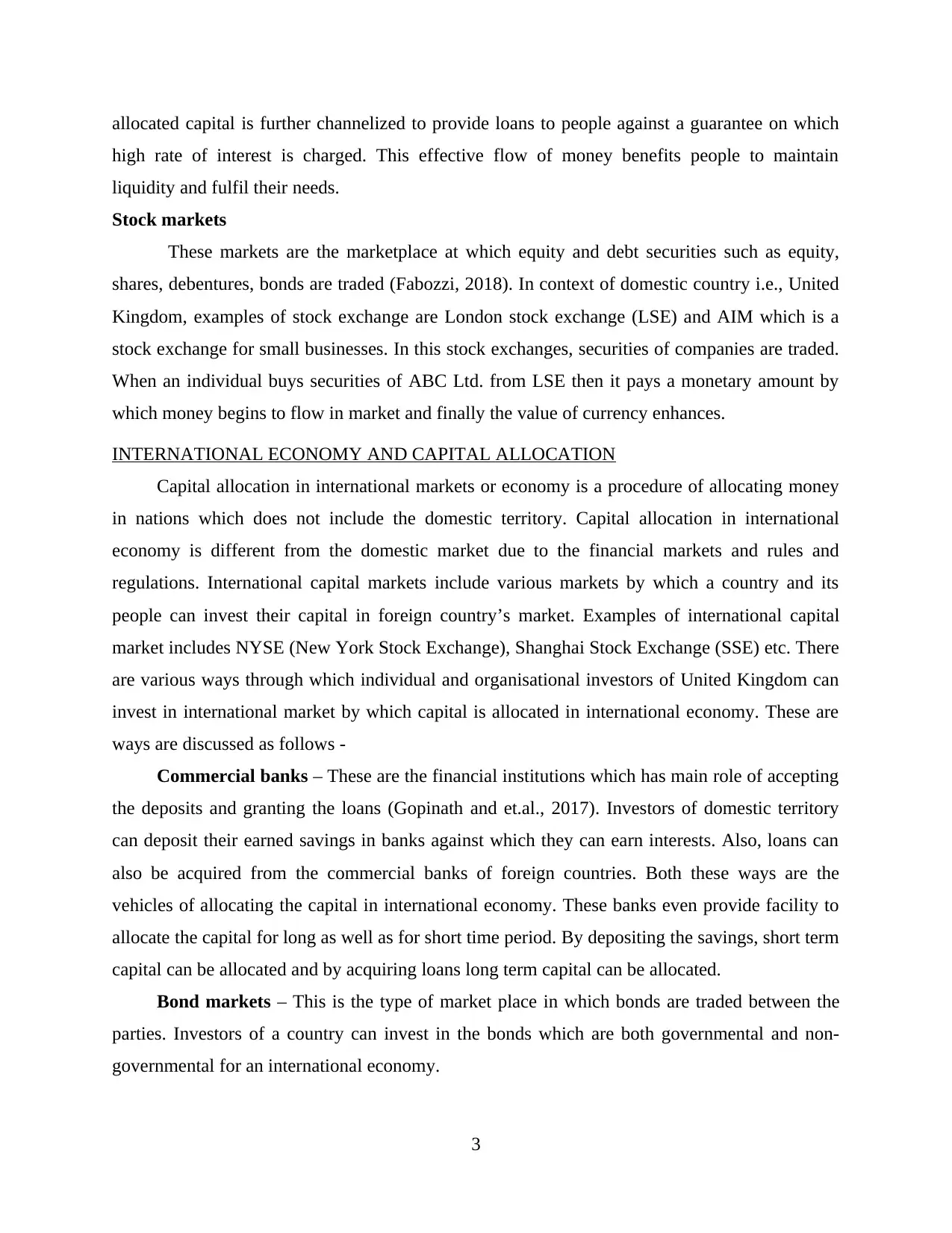
allocated capital is further channelized to provide loans to people against a guarantee on which
high rate of interest is charged. This effective flow of money benefits people to maintain
liquidity and fulfil their needs.
Stock markets
These markets are the marketplace at which equity and debt securities such as equity,
shares, debentures, bonds are traded (Fabozzi, 2018). In context of domestic country i.e., United
Kingdom, examples of stock exchange are London stock exchange (LSE) and AIM which is a
stock exchange for small businesses. In this stock exchanges, securities of companies are traded.
When an individual buys securities of ABC Ltd. from LSE then it pays a monetary amount by
which money begins to flow in market and finally the value of currency enhances.
INTERNATIONAL ECONOMY AND CAPITAL ALLOCATION
Capital allocation in international markets or economy is a procedure of allocating money
in nations which does not include the domestic territory. Capital allocation in international
economy is different from the domestic market due to the financial markets and rules and
regulations. International capital markets include various markets by which a country and its
people can invest their capital in foreign country’s market. Examples of international capital
market includes NYSE (New York Stock Exchange), Shanghai Stock Exchange (SSE) etc. There
are various ways through which individual and organisational investors of United Kingdom can
invest in international market by which capital is allocated in international economy. These are
ways are discussed as follows -
Commercial banks – These are the financial institutions which has main role of accepting
the deposits and granting the loans (Gopinath and et.al., 2017). Investors of domestic territory
can deposit their earned savings in banks against which they can earn interests. Also, loans can
also be acquired from the commercial banks of foreign countries. Both these ways are the
vehicles of allocating the capital in international economy. These banks even provide facility to
allocate the capital for long as well as for short time period. By depositing the savings, short term
capital can be allocated and by acquiring loans long term capital can be allocated.
Bond markets – This is the type of market place in which bonds are traded between the
parties. Investors of a country can invest in the bonds which are both governmental and non-
governmental for an international economy.
3
high rate of interest is charged. This effective flow of money benefits people to maintain
liquidity and fulfil their needs.
Stock markets
These markets are the marketplace at which equity and debt securities such as equity,
shares, debentures, bonds are traded (Fabozzi, 2018). In context of domestic country i.e., United
Kingdom, examples of stock exchange are London stock exchange (LSE) and AIM which is a
stock exchange for small businesses. In this stock exchanges, securities of companies are traded.
When an individual buys securities of ABC Ltd. from LSE then it pays a monetary amount by
which money begins to flow in market and finally the value of currency enhances.
INTERNATIONAL ECONOMY AND CAPITAL ALLOCATION
Capital allocation in international markets or economy is a procedure of allocating money
in nations which does not include the domestic territory. Capital allocation in international
economy is different from the domestic market due to the financial markets and rules and
regulations. International capital markets include various markets by which a country and its
people can invest their capital in foreign country’s market. Examples of international capital
market includes NYSE (New York Stock Exchange), Shanghai Stock Exchange (SSE) etc. There
are various ways through which individual and organisational investors of United Kingdom can
invest in international market by which capital is allocated in international economy. These are
ways are discussed as follows -
Commercial banks – These are the financial institutions which has main role of accepting
the deposits and granting the loans (Gopinath and et.al., 2017). Investors of domestic territory
can deposit their earned savings in banks against which they can earn interests. Also, loans can
also be acquired from the commercial banks of foreign countries. Both these ways are the
vehicles of allocating the capital in international economy. These banks even provide facility to
allocate the capital for long as well as for short time period. By depositing the savings, short term
capital can be allocated and by acquiring loans long term capital can be allocated.
Bond markets – This is the type of market place in which bonds are traded between the
parties. Investors of a country can invest in the bonds which are both governmental and non-
governmental for an international economy.
3
⊘ This is a preview!⊘
Do you want full access?
Subscribe today to unlock all pages.

Trusted by 1+ million students worldwide
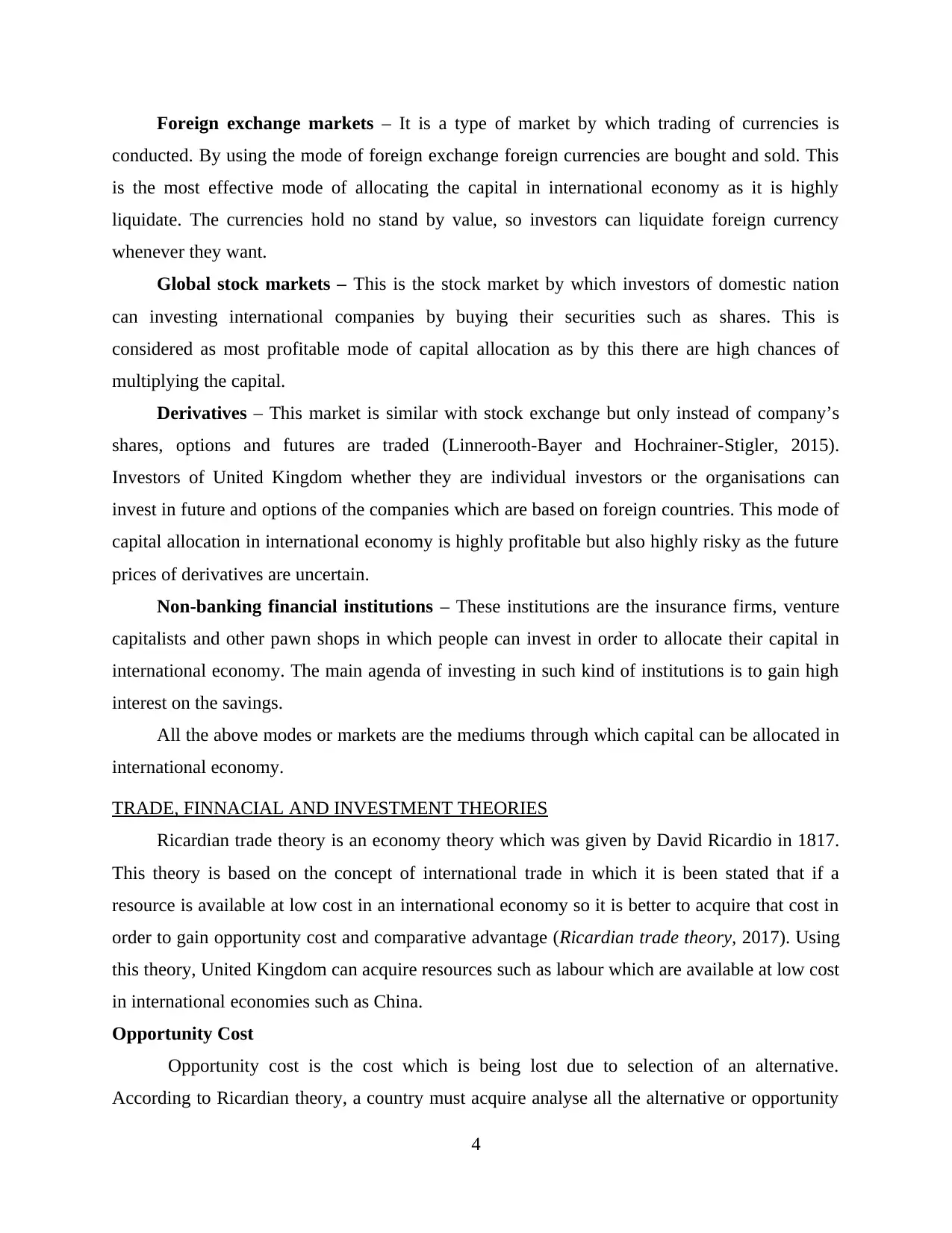
Foreign exchange markets – It is a type of market by which trading of currencies is
conducted. By using the mode of foreign exchange foreign currencies are bought and sold. This
is the most effective mode of allocating the capital in international economy as it is highly
liquidate. The currencies hold no stand by value, so investors can liquidate foreign currency
whenever they want.
Global stock markets – This is the stock market by which investors of domestic nation
can investing international companies by buying their securities such as shares. This is
considered as most profitable mode of capital allocation as by this there are high chances of
multiplying the capital.
Derivatives – This market is similar with stock exchange but only instead of company’s
shares, options and futures are traded (Linnerooth-Bayer and Hochrainer-Stigler, 2015).
Investors of United Kingdom whether they are individual investors or the organisations can
invest in future and options of the companies which are based on foreign countries. This mode of
capital allocation in international economy is highly profitable but also highly risky as the future
prices of derivatives are uncertain.
Non-banking financial institutions – These institutions are the insurance firms, venture
capitalists and other pawn shops in which people can invest in order to allocate their capital in
international economy. The main agenda of investing in such kind of institutions is to gain high
interest on the savings.
All the above modes or markets are the mediums through which capital can be allocated in
international economy.
TRADE, FINNACIAL AND INVESTMENT THEORIES
Ricardian trade theory is an economy theory which was given by David Ricardio in 1817.
This theory is based on the concept of international trade in which it is been stated that if a
resource is available at low cost in an international economy so it is better to acquire that cost in
order to gain opportunity cost and comparative advantage (Ricardian trade theory, 2017). Using
this theory, United Kingdom can acquire resources such as labour which are available at low cost
in international economies such as China.
Opportunity Cost
Opportunity cost is the cost which is being lost due to selection of an alternative.
According to Ricardian theory, a country must acquire analyse all the alternative or opportunity
4
conducted. By using the mode of foreign exchange foreign currencies are bought and sold. This
is the most effective mode of allocating the capital in international economy as it is highly
liquidate. The currencies hold no stand by value, so investors can liquidate foreign currency
whenever they want.
Global stock markets – This is the stock market by which investors of domestic nation
can investing international companies by buying their securities such as shares. This is
considered as most profitable mode of capital allocation as by this there are high chances of
multiplying the capital.
Derivatives – This market is similar with stock exchange but only instead of company’s
shares, options and futures are traded (Linnerooth-Bayer and Hochrainer-Stigler, 2015).
Investors of United Kingdom whether they are individual investors or the organisations can
invest in future and options of the companies which are based on foreign countries. This mode of
capital allocation in international economy is highly profitable but also highly risky as the future
prices of derivatives are uncertain.
Non-banking financial institutions – These institutions are the insurance firms, venture
capitalists and other pawn shops in which people can invest in order to allocate their capital in
international economy. The main agenda of investing in such kind of institutions is to gain high
interest on the savings.
All the above modes or markets are the mediums through which capital can be allocated in
international economy.
TRADE, FINNACIAL AND INVESTMENT THEORIES
Ricardian trade theory is an economy theory which was given by David Ricardio in 1817.
This theory is based on the concept of international trade in which it is been stated that if a
resource is available at low cost in an international economy so it is better to acquire that cost in
order to gain opportunity cost and comparative advantage (Ricardian trade theory, 2017). Using
this theory, United Kingdom can acquire resources such as labour which are available at low cost
in international economies such as China.
Opportunity Cost
Opportunity cost is the cost which is being lost due to selection of an alternative.
According to Ricardian theory, a country must acquire analyse all the alternative or opportunity
4
Paraphrase This Document
Need a fresh take? Get an instant paraphrase of this document with our AI Paraphraser
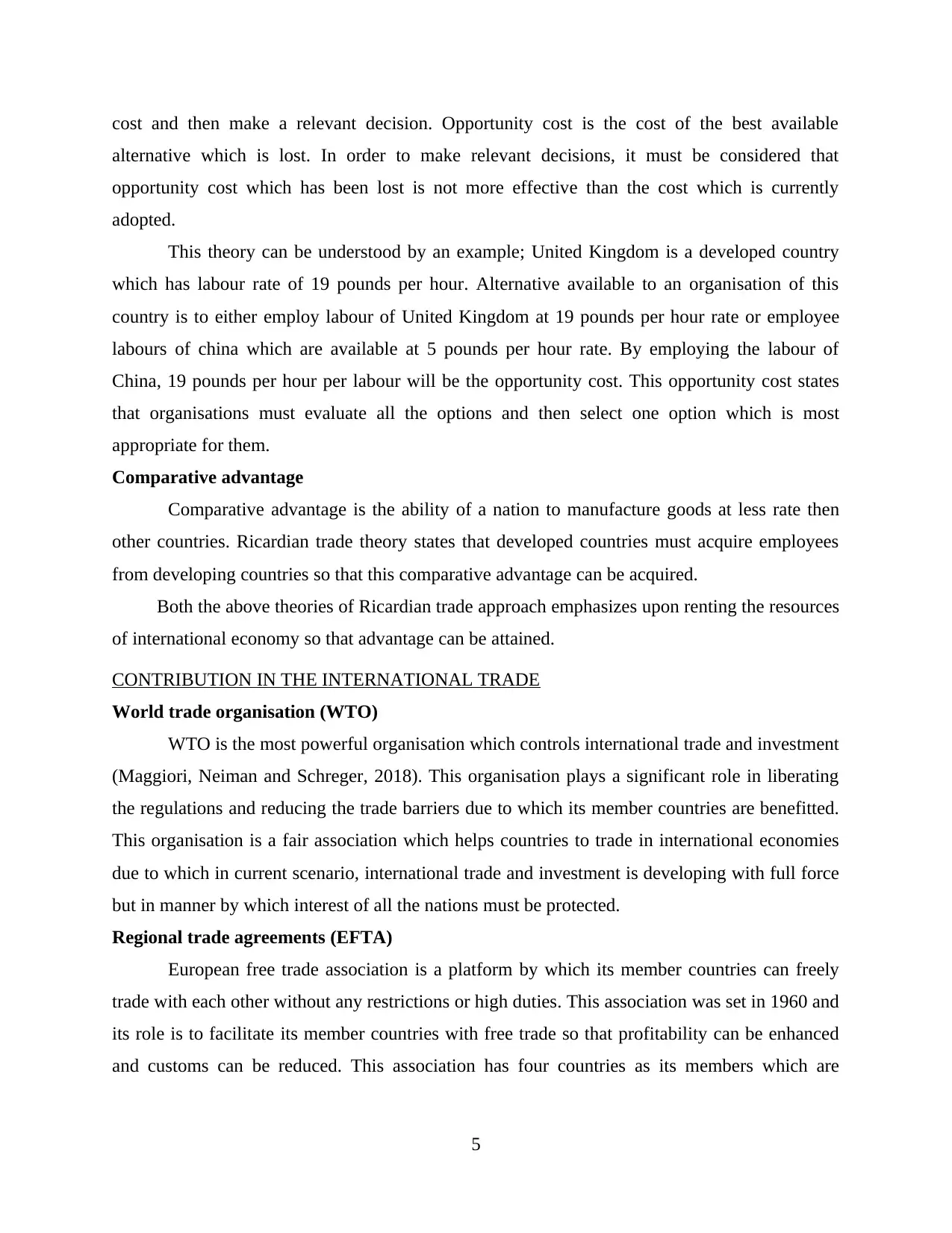
cost and then make a relevant decision. Opportunity cost is the cost of the best available
alternative which is lost. In order to make relevant decisions, it must be considered that
opportunity cost which has been lost is not more effective than the cost which is currently
adopted.
This theory can be understood by an example; United Kingdom is a developed country
which has labour rate of 19 pounds per hour. Alternative available to an organisation of this
country is to either employ labour of United Kingdom at 19 pounds per hour rate or employee
labours of china which are available at 5 pounds per hour rate. By employing the labour of
China, 19 pounds per hour per labour will be the opportunity cost. This opportunity cost states
that organisations must evaluate all the options and then select one option which is most
appropriate for them.
Comparative advantage
Comparative advantage is the ability of a nation to manufacture goods at less rate then
other countries. Ricardian trade theory states that developed countries must acquire employees
from developing countries so that this comparative advantage can be acquired.
Both the above theories of Ricardian trade approach emphasizes upon renting the resources
of international economy so that advantage can be attained.
CONTRIBUTION IN THE INTERNATIONAL TRADE
World trade organisation (WTO)
WTO is the most powerful organisation which controls international trade and investment
(Maggiori, Neiman and Schreger, 2018). This organisation plays a significant role in liberating
the regulations and reducing the trade barriers due to which its member countries are benefitted.
This organisation is a fair association which helps countries to trade in international economies
due to which in current scenario, international trade and investment is developing with full force
but in manner by which interest of all the nations must be protected.
Regional trade agreements (EFTA)
European free trade association is a platform by which its member countries can freely
trade with each other without any restrictions or high duties. This association was set in 1960 and
its role is to facilitate its member countries with free trade so that profitability can be enhanced
and customs can be reduced. This association has four countries as its members which are
5
alternative which is lost. In order to make relevant decisions, it must be considered that
opportunity cost which has been lost is not more effective than the cost which is currently
adopted.
This theory can be understood by an example; United Kingdom is a developed country
which has labour rate of 19 pounds per hour. Alternative available to an organisation of this
country is to either employ labour of United Kingdom at 19 pounds per hour rate or employee
labours of china which are available at 5 pounds per hour rate. By employing the labour of
China, 19 pounds per hour per labour will be the opportunity cost. This opportunity cost states
that organisations must evaluate all the options and then select one option which is most
appropriate for them.
Comparative advantage
Comparative advantage is the ability of a nation to manufacture goods at less rate then
other countries. Ricardian trade theory states that developed countries must acquire employees
from developing countries so that this comparative advantage can be acquired.
Both the above theories of Ricardian trade approach emphasizes upon renting the resources
of international economy so that advantage can be attained.
CONTRIBUTION IN THE INTERNATIONAL TRADE
World trade organisation (WTO)
WTO is the most powerful organisation which controls international trade and investment
(Maggiori, Neiman and Schreger, 2018). This organisation plays a significant role in liberating
the regulations and reducing the trade barriers due to which its member countries are benefitted.
This organisation is a fair association which helps countries to trade in international economies
due to which in current scenario, international trade and investment is developing with full force
but in manner by which interest of all the nations must be protected.
Regional trade agreements (EFTA)
European free trade association is a platform by which its member countries can freely
trade with each other without any restrictions or high duties. This association was set in 1960 and
its role is to facilitate its member countries with free trade so that profitability can be enhanced
and customs can be reduced. This association has four countries as its members which are
5
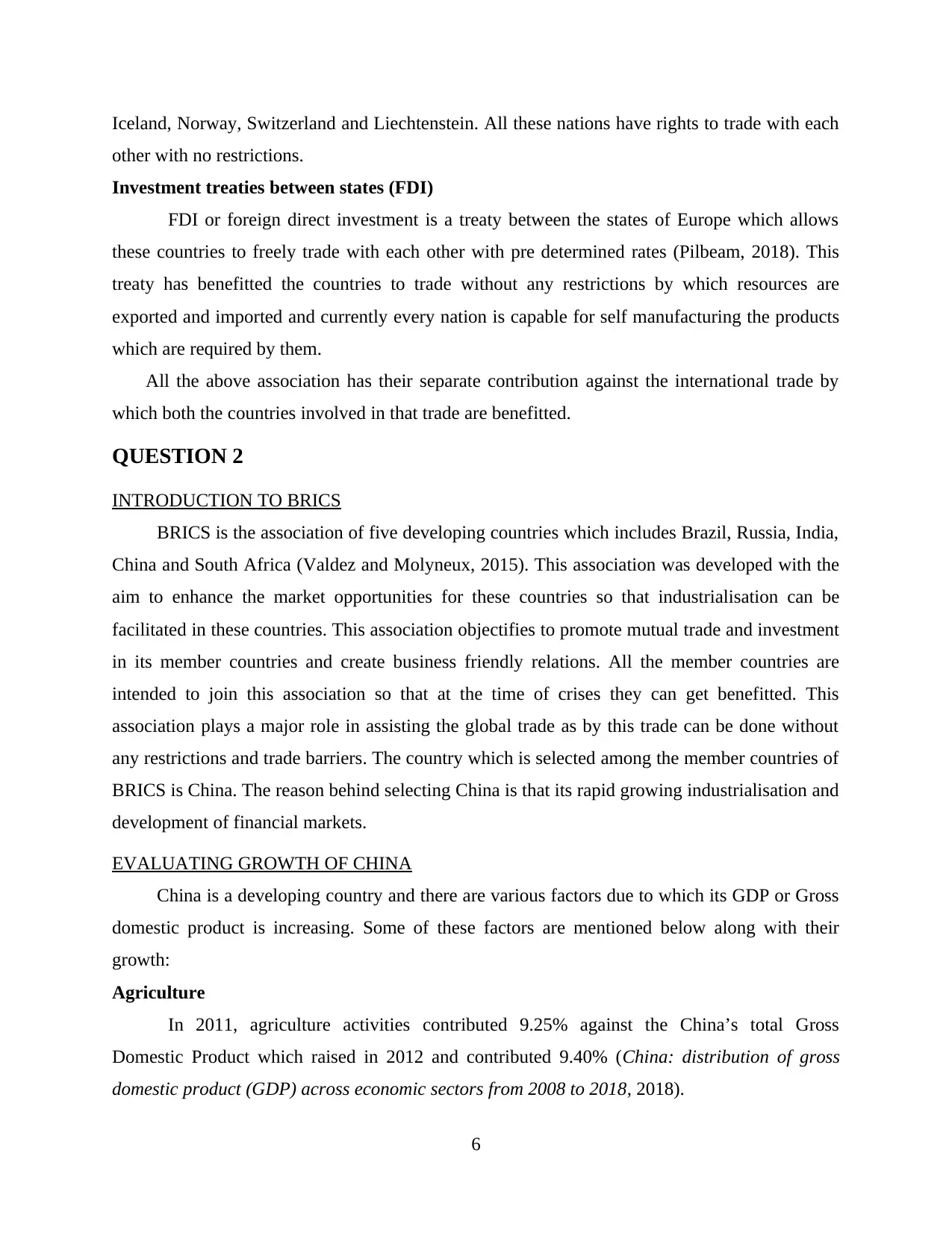
Iceland, Norway, Switzerland and Liechtenstein. All these nations have rights to trade with each
other with no restrictions.
Investment treaties between states (FDI)
FDI or foreign direct investment is a treaty between the states of Europe which allows
these countries to freely trade with each other with pre determined rates (Pilbeam, 2018). This
treaty has benefitted the countries to trade without any restrictions by which resources are
exported and imported and currently every nation is capable for self manufacturing the products
which are required by them.
All the above association has their separate contribution against the international trade by
which both the countries involved in that trade are benefitted.
QUESTION 2
INTRODUCTION TO BRICS
BRICS is the association of five developing countries which includes Brazil, Russia, India,
China and South Africa (Valdez and Molyneux, 2015). This association was developed with the
aim to enhance the market opportunities for these countries so that industrialisation can be
facilitated in these countries. This association objectifies to promote mutual trade and investment
in its member countries and create business friendly relations. All the member countries are
intended to join this association so that at the time of crises they can get benefitted. This
association plays a major role in assisting the global trade as by this trade can be done without
any restrictions and trade barriers. The country which is selected among the member countries of
BRICS is China. The reason behind selecting China is that its rapid growing industrialisation and
development of financial markets.
EVALUATING GROWTH OF CHINA
China is a developing country and there are various factors due to which its GDP or Gross
domestic product is increasing. Some of these factors are mentioned below along with their
growth:
Agriculture
In 2011, agriculture activities contributed 9.25% against the China’s total Gross
Domestic Product which raised in 2012 and contributed 9.40% (China: distribution of gross
domestic product (GDP) across economic sectors from 2008 to 2018, 2018).
6
other with no restrictions.
Investment treaties between states (FDI)
FDI or foreign direct investment is a treaty between the states of Europe which allows
these countries to freely trade with each other with pre determined rates (Pilbeam, 2018). This
treaty has benefitted the countries to trade without any restrictions by which resources are
exported and imported and currently every nation is capable for self manufacturing the products
which are required by them.
All the above association has their separate contribution against the international trade by
which both the countries involved in that trade are benefitted.
QUESTION 2
INTRODUCTION TO BRICS
BRICS is the association of five developing countries which includes Brazil, Russia, India,
China and South Africa (Valdez and Molyneux, 2015). This association was developed with the
aim to enhance the market opportunities for these countries so that industrialisation can be
facilitated in these countries. This association objectifies to promote mutual trade and investment
in its member countries and create business friendly relations. All the member countries are
intended to join this association so that at the time of crises they can get benefitted. This
association plays a major role in assisting the global trade as by this trade can be done without
any restrictions and trade barriers. The country which is selected among the member countries of
BRICS is China. The reason behind selecting China is that its rapid growing industrialisation and
development of financial markets.
EVALUATING GROWTH OF CHINA
China is a developing country and there are various factors due to which its GDP or Gross
domestic product is increasing. Some of these factors are mentioned below along with their
growth:
Agriculture
In 2011, agriculture activities contributed 9.25% against the China’s total Gross
Domestic Product which raised in 2012 and contributed 9.40% (China: distribution of gross
domestic product (GDP) across economic sectors from 2008 to 2018, 2018).
6
⊘ This is a preview!⊘
Do you want full access?
Subscribe today to unlock all pages.

Trusted by 1+ million students worldwide
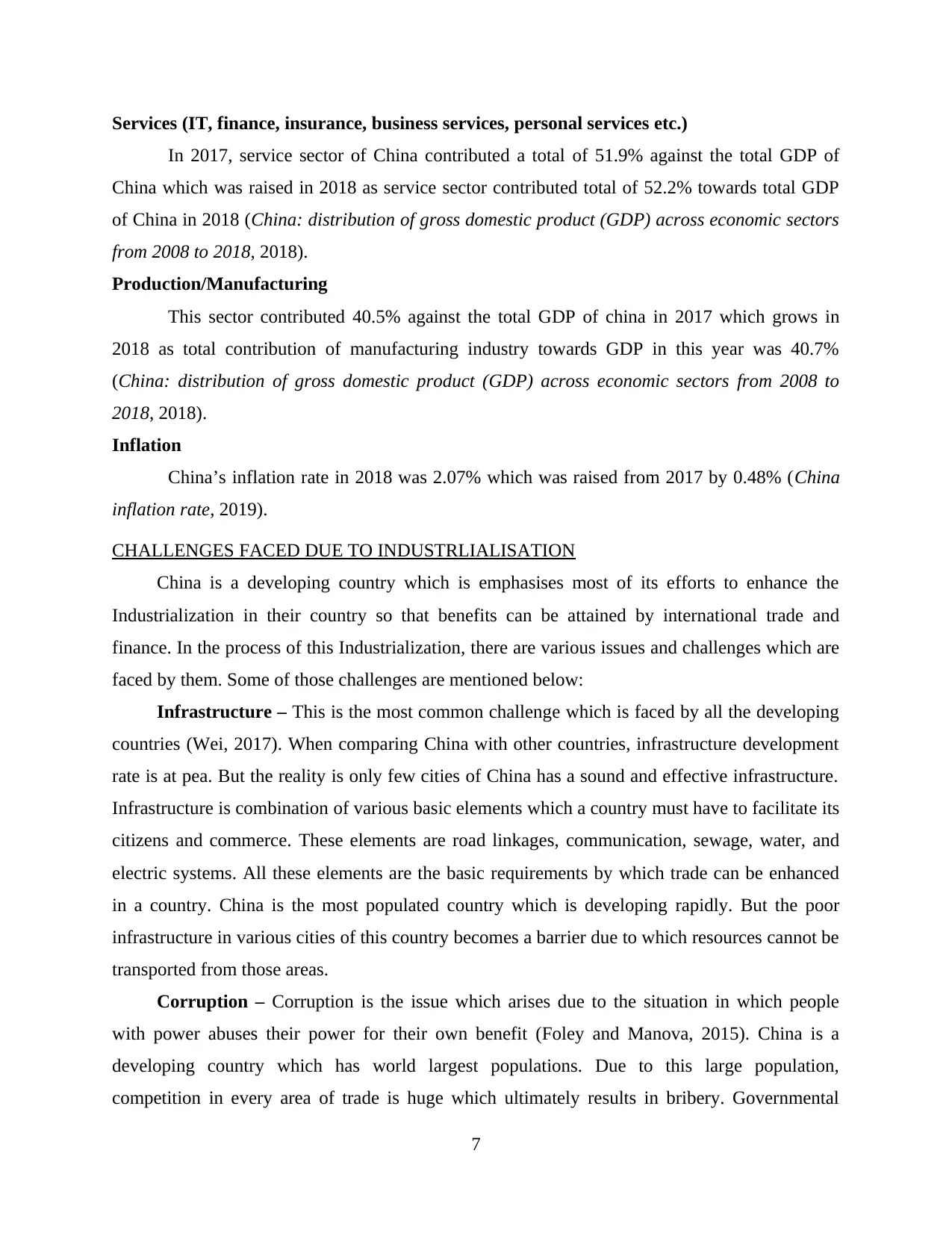
Services (IT, finance, insurance, business services, personal services etc.)
In 2017, service sector of China contributed a total of 51.9% against the total GDP of
China which was raised in 2018 as service sector contributed total of 52.2% towards total GDP
of China in 2018 (China: distribution of gross domestic product (GDP) across economic sectors
from 2008 to 2018, 2018).
Production/Manufacturing
This sector contributed 40.5% against the total GDP of china in 2017 which grows in
2018 as total contribution of manufacturing industry towards GDP in this year was 40.7%
(China: distribution of gross domestic product (GDP) across economic sectors from 2008 to
2018, 2018).
Inflation
China’s inflation rate in 2018 was 2.07% which was raised from 2017 by 0.48% (China
inflation rate, 2019).
CHALLENGES FACED DUE TO INDUSTRLIALISATION
China is a developing country which is emphasises most of its efforts to enhance the
Industrialization in their country so that benefits can be attained by international trade and
finance. In the process of this Industrialization, there are various issues and challenges which are
faced by them. Some of those challenges are mentioned below:
Infrastructure – This is the most common challenge which is faced by all the developing
countries (Wei, 2017). When comparing China with other countries, infrastructure development
rate is at pea. But the reality is only few cities of China has a sound and effective infrastructure.
Infrastructure is combination of various basic elements which a country must have to facilitate its
citizens and commerce. These elements are road linkages, communication, sewage, water, and
electric systems. All these elements are the basic requirements by which trade can be enhanced
in a country. China is the most populated country which is developing rapidly. But the poor
infrastructure in various cities of this country becomes a barrier due to which resources cannot be
transported from those areas.
Corruption – Corruption is the issue which arises due to the situation in which people
with power abuses their power for their own benefit (Foley and Manova, 2015). China is a
developing country which has world largest populations. Due to this large population,
competition in every area of trade is huge which ultimately results in bribery. Governmental
7
In 2017, service sector of China contributed a total of 51.9% against the total GDP of
China which was raised in 2018 as service sector contributed total of 52.2% towards total GDP
of China in 2018 (China: distribution of gross domestic product (GDP) across economic sectors
from 2008 to 2018, 2018).
Production/Manufacturing
This sector contributed 40.5% against the total GDP of china in 2017 which grows in
2018 as total contribution of manufacturing industry towards GDP in this year was 40.7%
(China: distribution of gross domestic product (GDP) across economic sectors from 2008 to
2018, 2018).
Inflation
China’s inflation rate in 2018 was 2.07% which was raised from 2017 by 0.48% (China
inflation rate, 2019).
CHALLENGES FACED DUE TO INDUSTRLIALISATION
China is a developing country which is emphasises most of its efforts to enhance the
Industrialization in their country so that benefits can be attained by international trade and
finance. In the process of this Industrialization, there are various issues and challenges which are
faced by them. Some of those challenges are mentioned below:
Infrastructure – This is the most common challenge which is faced by all the developing
countries (Wei, 2017). When comparing China with other countries, infrastructure development
rate is at pea. But the reality is only few cities of China has a sound and effective infrastructure.
Infrastructure is combination of various basic elements which a country must have to facilitate its
citizens and commerce. These elements are road linkages, communication, sewage, water, and
electric systems. All these elements are the basic requirements by which trade can be enhanced
in a country. China is the most populated country which is developing rapidly. But the poor
infrastructure in various cities of this country becomes a barrier due to which resources cannot be
transported from those areas.
Corruption – Corruption is the issue which arises due to the situation in which people
with power abuses their power for their own benefit (Foley and Manova, 2015). China is a
developing country which has world largest populations. Due to this large population,
competition in every area of trade is huge which ultimately results in bribery. Governmental
7
Paraphrase This Document
Need a fresh take? Get an instant paraphrase of this document with our AI Paraphraser
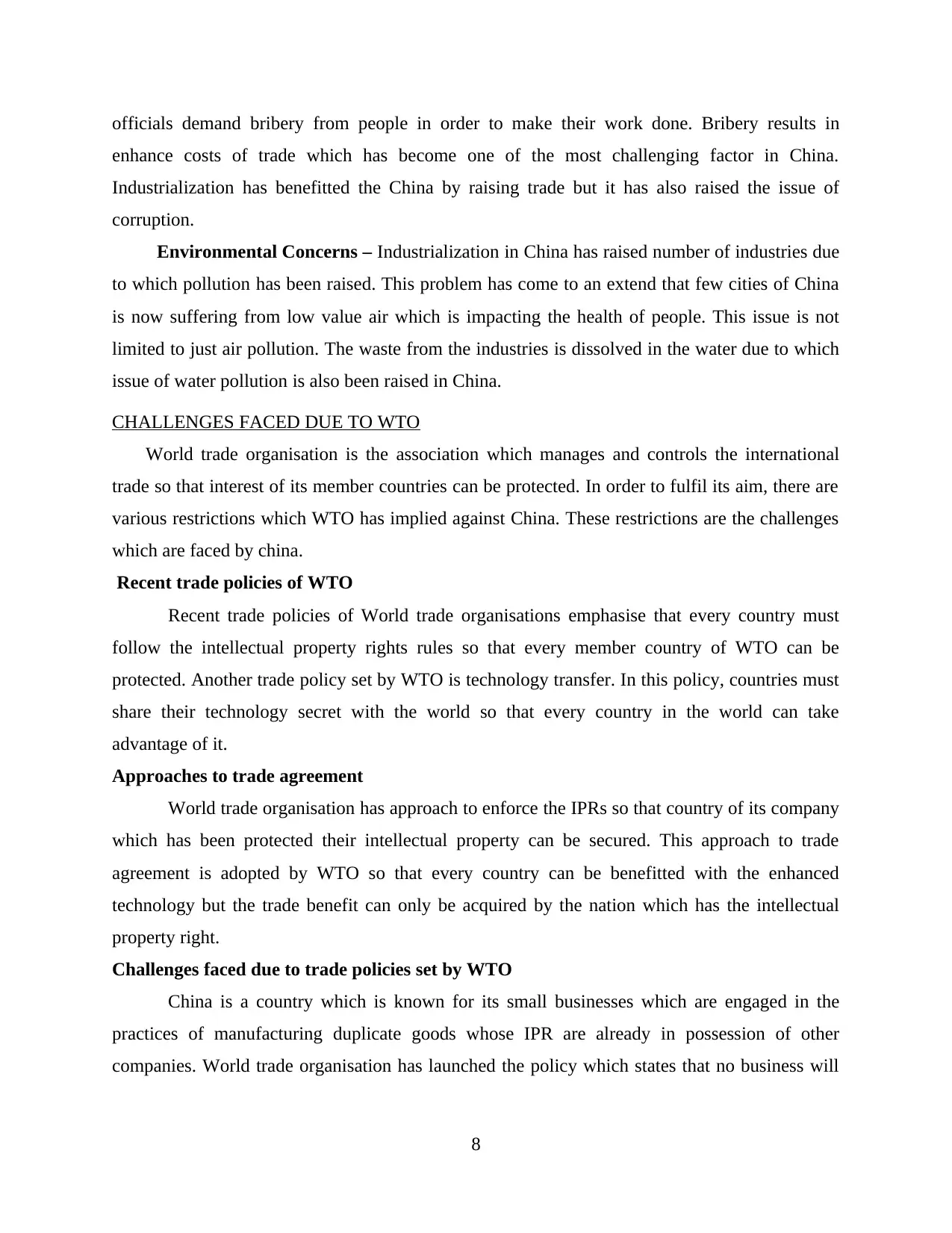
officials demand bribery from people in order to make their work done. Bribery results in
enhance costs of trade which has become one of the most challenging factor in China.
Industrialization has benefitted the China by raising trade but it has also raised the issue of
corruption.
Environmental Concerns – Industrialization in China has raised number of industries due
to which pollution has been raised. This problem has come to an extend that few cities of China
is now suffering from low value air which is impacting the health of people. This issue is not
limited to just air pollution. The waste from the industries is dissolved in the water due to which
issue of water pollution is also been raised in China.
CHALLENGES FACED DUE TO WTO
World trade organisation is the association which manages and controls the international
trade so that interest of its member countries can be protected. In order to fulfil its aim, there are
various restrictions which WTO has implied against China. These restrictions are the challenges
which are faced by china.
Recent trade policies of WTO
Recent trade policies of World trade organisations emphasise that every country must
follow the intellectual property rights rules so that every member country of WTO can be
protected. Another trade policy set by WTO is technology transfer. In this policy, countries must
share their technology secret with the world so that every country in the world can take
advantage of it.
Approaches to trade agreement
World trade organisation has approach to enforce the IPRs so that country of its company
which has been protected their intellectual property can be secured. This approach to trade
agreement is adopted by WTO so that every country can be benefitted with the enhanced
technology but the trade benefit can only be acquired by the nation which has the intellectual
property right.
Challenges faced due to trade policies set by WTO
China is a country which is known for its small businesses which are engaged in the
practices of manufacturing duplicate goods whose IPR are already in possession of other
companies. World trade organisation has launched the policy which states that no business will
8
enhance costs of trade which has become one of the most challenging factor in China.
Industrialization has benefitted the China by raising trade but it has also raised the issue of
corruption.
Environmental Concerns – Industrialization in China has raised number of industries due
to which pollution has been raised. This problem has come to an extend that few cities of China
is now suffering from low value air which is impacting the health of people. This issue is not
limited to just air pollution. The waste from the industries is dissolved in the water due to which
issue of water pollution is also been raised in China.
CHALLENGES FACED DUE TO WTO
World trade organisation is the association which manages and controls the international
trade so that interest of its member countries can be protected. In order to fulfil its aim, there are
various restrictions which WTO has implied against China. These restrictions are the challenges
which are faced by china.
Recent trade policies of WTO
Recent trade policies of World trade organisations emphasise that every country must
follow the intellectual property rights rules so that every member country of WTO can be
protected. Another trade policy set by WTO is technology transfer. In this policy, countries must
share their technology secret with the world so that every country in the world can take
advantage of it.
Approaches to trade agreement
World trade organisation has approach to enforce the IPRs so that country of its company
which has been protected their intellectual property can be secured. This approach to trade
agreement is adopted by WTO so that every country can be benefitted with the enhanced
technology but the trade benefit can only be acquired by the nation which has the intellectual
property right.
Challenges faced due to trade policies set by WTO
China is a country which is known for its small businesses which are engaged in the
practices of manufacturing duplicate goods whose IPR are already in possession of other
companies. World trade organisation has launched the policy which states that no business will
8
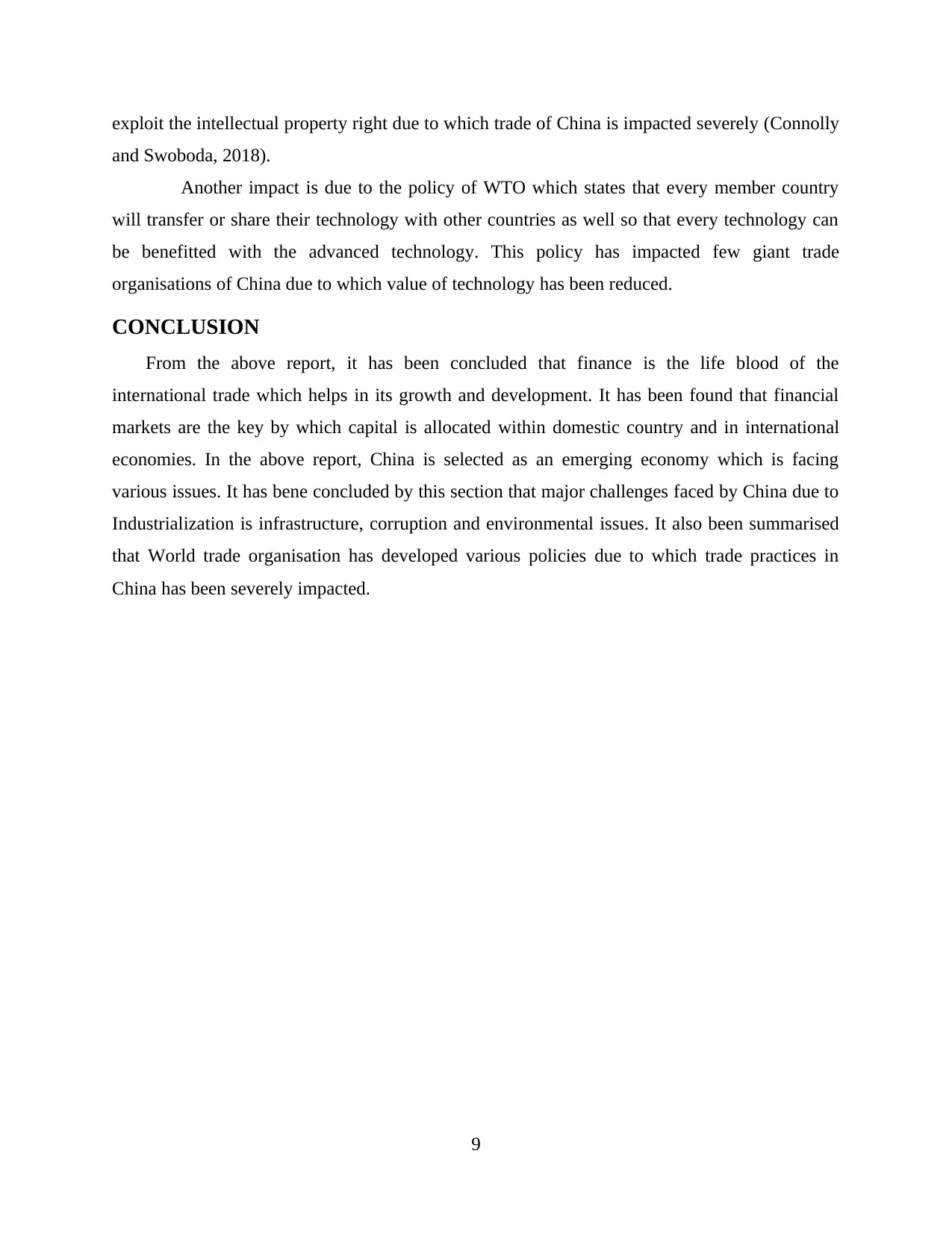
exploit the intellectual property right due to which trade of China is impacted severely (Connolly
and Swoboda, 2018).
Another impact is due to the policy of WTO which states that every member country
will transfer or share their technology with other countries as well so that every technology can
be benefitted with the advanced technology. This policy has impacted few giant trade
organisations of China due to which value of technology has been reduced.
CONCLUSION
From the above report, it has been concluded that finance is the life blood of the
international trade which helps in its growth and development. It has been found that financial
markets are the key by which capital is allocated within domestic country and in international
economies. In the above report, China is selected as an emerging economy which is facing
various issues. It has bene concluded by this section that major challenges faced by China due to
Industrialization is infrastructure, corruption and environmental issues. It also been summarised
that World trade organisation has developed various policies due to which trade practices in
China has been severely impacted.
9
and Swoboda, 2018).
Another impact is due to the policy of WTO which states that every member country
will transfer or share their technology with other countries as well so that every technology can
be benefitted with the advanced technology. This policy has impacted few giant trade
organisations of China due to which value of technology has been reduced.
CONCLUSION
From the above report, it has been concluded that finance is the life blood of the
international trade which helps in its growth and development. It has been found that financial
markets are the key by which capital is allocated within domestic country and in international
economies. In the above report, China is selected as an emerging economy which is facing
various issues. It has bene concluded by this section that major challenges faced by China due to
Industrialization is infrastructure, corruption and environmental issues. It also been summarised
that World trade organisation has developed various policies due to which trade practices in
China has been severely impacted.
9
⊘ This is a preview!⊘
Do you want full access?
Subscribe today to unlock all pages.

Trusted by 1+ million students worldwide
1 out of 13
Related Documents
Your All-in-One AI-Powered Toolkit for Academic Success.
+13062052269
info@desklib.com
Available 24*7 on WhatsApp / Email
![[object Object]](/_next/static/media/star-bottom.7253800d.svg)
Unlock your academic potential
Copyright © 2020–2026 A2Z Services. All Rights Reserved. Developed and managed by ZUCOL.





